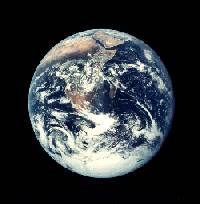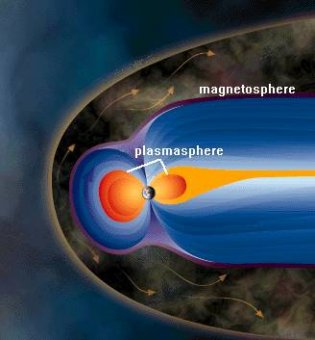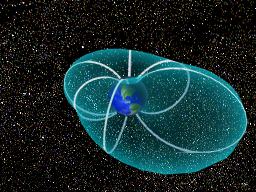
 Space Science News home
Space Science News homeA new model of the plasmasphere
surrounding our world
Sept. 7, 1999: As photographed from space, the Earth looks like it is floating in a black void. But, unseen by our eyes and most cameras, the Earth is actually surrounded by a complex system of interacting electric and magnetic fields, electric currents and charged particles called the magnetosphere.
Right: If a camera didn't compensate for the bright sunlight in space, stars would be seen in the background and the Earth would appear as a bright white orb. Because distant stars aren't as bright as the Earth, a low photo exposure results in a black background.
The magnetosphere provides a barrier between our planet and particles continually given off by the Sun's corona called the "solar wind." These particles constitute a plasma - a mixture of electrons (negatively charged) and ions (atoms that have lost electrons, resulting in a positive electric charge).
Plasma is not a gas, liquid, or solid - it is the fourth state of matter. Plasma often behaves like a gas, except that it conducts electricity and is affected by magnetic fields. On an astronomical scale, plasma is common. The Sun is composed of plasma, fire is plasma, fluorescent and neon lights contain plasma. "99.9 percent of the Universe is made up of plasma, " says Dr. Dennis Gallagher, a plasma physicist at NASA's Marshall Space Flight Center. "Very little material in space is made of rock like the Earth."
"99.9 percent of the Universe is made up of plasma, " says Dr. Dennis Gallagher, a plasma physicist at NASA's Marshall Space Flight Center. "Very little material in space is made of rock like the Earth."
The plasma of the magnetosphere has many different levels of temperature and concentration. The coldest magnetospheric plasma is most often found in the plasmasphere, a donut-shaped region surrounding the Earth's middle. But plasma from the plasmasphere can be detected throughout the magnetosphere because it gets blown around by electric and magnetic forces.
Left: Artist's concept of the magnetosphere. The rounded, bullet-like shape represents the bow shock as the magnetosphere confronts solar winds. The area represented in gray, between the magnetosphere and the bow shock, is called the magnetopause. The Earth's magnetosphere extends about 10 Earth radii toward the Sun and perhaps similar distances outward on the flanks The magnetotail is thought to extend as far as 1, 000 Earth radii away from the Sun.
 Gallagher has developed a general model to describe the density of the plasma surrounding the Earth. His paper, "Global Core Plasma Model, " will be published in the Journal of Geophysical Research. "Core plasma" refers to the low-energy plasma (zero to 100 electron volts) that makes up the plasmasphere.
Gallagher has developed a general model to describe the density of the plasma surrounding the Earth. His paper, "Global Core Plasma Model, " will be published in the Journal of Geophysical Research. "Core plasma" refers to the low-energy plasma (zero to 100 electron volts) that makes up the plasmasphere.
The plasmasphere extends out to as little as 2 to 3 Earth radii and, under quiet conditions on the evening side, perhaps more than 6 Earth radii. (Because conditions in space constantly vary and regions never have exact boundaries, plasma physicists measure the plasmasphere relative to the size of Earth: 4, 000 miles [6, 400 km] is about one Earth radius.) The extent of the plasmasphere depends on space weather activity. High levels of activity erode the plasmasphere; long periods of quiet allow the plasmasphere to expand.
 Right: Click the image for a 3D simulation of the magnetosphere's shape. The Sun is off screen to the left. The animation begins showing the Earth, which recedes as the shape and size of the magnetosphere comes into view. The solar wind deforms the magnetosphere into its characteristic shape. Where the magnetosphere and the solar wind meet is the "bow shock, " represented in the animation by a faint, translucent bullet shape. Credit: Digital Radiance
Right: Click the image for a 3D simulation of the magnetosphere's shape. The Sun is off screen to the left. The animation begins showing the Earth, which recedes as the shape and size of the magnetosphere comes into view. The solar wind deforms the magnetosphere into its characteristic shape. Where the magnetosphere and the solar wind meet is the "bow shock, " represented in the animation by a faint, translucent bullet shape. Credit: Digital Radiance
"We've been flying in plasma for over 40 years and have slowly gained a statistical picture of what things are like, such as the density and proportion of oxygen, hydrogen, and helium, " says Gallagher.
ut our understanding of the plasmasphere is not complete. For one thing, all the various measurements have resulted in many independent models of specific plasma regions. By combining previous work, Gallagher's model attempts to describe, mathematically, a general, complete image of the plasmasphere.
Left: Animation of the Earth's plasmasphere as it would appear in extreme ultraviolet light (30.4 nm wavelength). This simulates the view from the IMAGE satellite due to launch in February 2000. To watch a QuickTime movie of this animation, click here (6.5MB file).
"This model begins to paint a picture, but it's something of a Frankenstein's monster, " says Gallagher, referring to how his model is pieced together from several different, dissimilar models. "A significant issue is how you smooth the stitches."
YOU MIGHT ALSO LIKE












